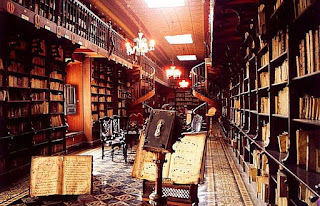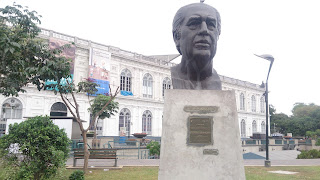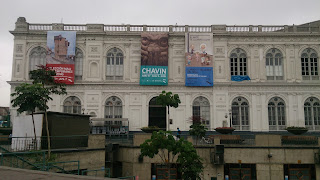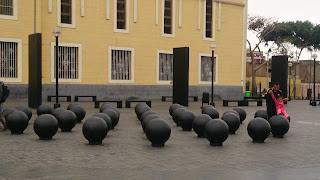El Metropolitano is a new Bus rapid transit system serving the city of Lima. Its construction began in the year 2006 during Luis Castañeda Lossio's period as Mayor of Lima. It serves only 3 lines but could connect the central Lima with Barranco and Miraflores. Actually, I should take a ride for S2.5.
Main street with many big brand names set up outlet here.
After lunch, I walked all the way back to Plaza Mayor
Iglesia de San Francisco / Monasterio de San Francisco
It is the jewel of colonial Lima. The church faces a small paved square, full of pigeons and portrait photographers. The outside is attractively painted in colonial yellow, but it is the interior that is fascinating; much of it is decorated in the geometrical Mudéjar (Andalusian Moorish) style.
Its outstanding features include the 17th-century library, with 25,000 leather-bound volumes and 6,000 parchments dating from 15th to the 18th century. The cupola has a superb Mudéjar carved wooden ceiling of Panamanian cedar, dating from 1625.
In a gallery above the nave of the church are 130 choir stalls and 71 panels with carvings of Franciscan saints, made of the same wood.
San Francisco has probably survived more recent earthquakes because of the solid base provided by its catacombs, which were used as Lima's cemetery until 1810. A network of underground chambers, which are open to public, contains hundreds of skulls and bones, stored in racks according to type.
Bones including thousands and thousands of human skulls are piled in eerie geometric patterns in the crypt of this church. This was the city's first cemetery, and the underground tunnels contain the earthly remains of some 75,000 people. The church is the best example of what is known as "Lima Baroque" style of architecture.
Library
Altar
Catacomb
"Last Supper" with Cuy
Garden
Followed the guide book, I tried to locate the restaurant of La Choza Nautica, a good place for yummy fish ceviche, with fresh and tasty seafood. From the menu with pictures, I chose this and got ... Well, still good
After having an early dinner, I got back to 1900 Backpacker Hostel to reclaim my luggage deposited earlier in the morning. Once I arrived, the reception told me that a lady would like to share the taxi with me to the airport. Well its's good, I could pay less. My companion is from Canada and has spent a year in Peru to experience her life.
Sunrise on 4-Jun over Atlantic
Waiting at Newark for transfer, for flight to Tokyo, my last stop-over (for 3 hours) before flying back home.
























































